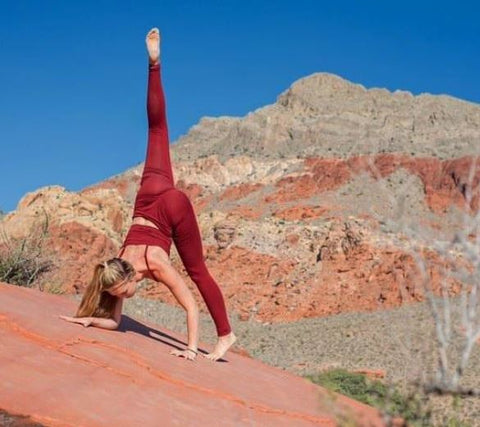So you have been practicing Yoga for a while now, but it seems a bit like group exercise or stretching with Sanskrit names... You may be wondering if that's all there is to Yoga. Maybe you're thinking there must be more to it? Well, there is. The exercise portion that we are all calling "Yoga" is practiced on your favorite yoga mat. So what is Yoga off the mat?
The complete Yogic Lifestyle was outlined in Patanjali's Yoga Sutras and came to be known as the Eight Limbs of Yoga. In the modern age, Yoga has come to focus heavily, if not exclusively, on just one of the eight limbs- Asanas or poses. If modern Yoga (as exercise) focuses on just one of the eight limbs, what are the other seven limbs and what does it mean to live a Yogic lifestyle?
What Are The Eight Limbs of Yoga?

In Patanjali's Yoga Sutras, the eightfold path is called ashtanga, which literally translates to “eight limbs” (ashta=eight, anga=limb). These eight steps, commonly known as the Eight Limbs of Yoga, are considered guidelines on how to live a meaningful and purposeful life.
The Eight Limbs of Yoga outline a complete path for Yogic spiritual development and living. They can be thought of as a step by step process, leading from the outer to the inner. Followers of all Eight Limbs of Yoga are known as Raja Yogis.
The Eight Limbs of Yoga include the Yamas, Niyamas, Asana, Pranayama, Pratyahara, Dharana, Dhyana and Samadhi and are said to result in Kaivalya (liberation).
The first two limbs, go together, the Yamas and Niyamas. These are all about how you live your life and can be thought of as morals or virtues; there are five of each.
The second, third and fourth limbs, Asana (poses), Pranayama (breath) and Pratyahara (going inward) are the limbs that many contemporary Yogis will be familiar with. This is because they are the physical practices and techniques used in modern Yoga classes.
The last three limbs, Dharana, Dhyana and Samadhi, are all related to meditation and states of mind.
Below you will find a general breakdown of what each limb constitutes:
- The Yamas are the things not to do. The Yamas include Ahimsa, Satya, Asteya, Brahmacharya and Aparigraha. Ahimsa is nonviolence. Satya is truthfulness. Asteya is no stealing. Brahmacharya is chastity, marital fidelity and sexual restraint. Aparigraha is not being greedy or possessive.
- The Niyamas are the things you should do. The Niyamas include Shaucha, Santosha, Tapas, Svadhyaya and Ishvarapranidhana. Shaucha is purity of mind, body and speech. Santosha is contentment and acceptance of circumstances, other people, yourself and life in general. Tapas is persistence and self discipline. Svadhyaya is study of the Vedas (holy scriptures), study of the self and introspection. Ishvarapranidhana is contemplation of Ishvara (God, your true self, absolute/unchanging reality, the universe).
- Asanas are the physical postures or poses one does in a contemporary Yoga class. Although there are now many different Yoga poses one could find oneself in, all Patanjali said on the matter was that they should be steady and comfortable. He was probably referring to how to position oneself in preparation for Pranayama and Meditation.

- Pranayamas are breath related practices. The prefix Prana is sometimes translated as energy, but it can also mean breath (Not all that surprising when Pranayamas are used to help channel our energy). The suffix ayama can be translated as restraint. So, Pranayama is control and restraint of the breath. There are many different types of Pranayamas for different goals. They often emphasize not only the inhalation and exhalation, but also the pause between each.
- Pratyahara's translation is related to catching or bringing near. During Pratyahara, you catch or bring your focus near to oneself by retracting your focus from the outside world and external stimuli; you start to go inward.

- Dharana's translation is related to holding or maintaining, but can be best thought of as focus. During Dharana the mind is introspective and one-pointed. The focus could be a mantra, the breath, etc. Regardless of the focus, you hold it in the mind without drifting or allowing other thoughts to enter.
- Dhyana is often translated as contemplation or reflection. During Dhyana, you non-judgmentally inspect whatever the focus of your Meditation is. Dhyana and Dharana are inextricably linked. Dharana can be thought of as the state of mind, Dhyana can be thought of as the process or method of inquiry.
- Samadhi can be translated a number of ways, but it is often thought of as joining, union, putting together, absorption, or as a profound meditative consciousness. It is the fruit or goal of the practice of all eight limbs.
Final Thoughts

The eight limbs of Yoga are a spiritual lifestyle you can follow on your path to liberation and enlightenment, also known as Moksha. They are quite literally the guidelines on how to live your life.
You start with the Yamas and Niyamas to live a moral, ethical and harmonious life. Then, you follow that by practicing Asana and Pranayama to clear any energetic blockages and prepare yourself for meditation. Once those are completed, you are ready to go inward. To do this you withdraw your senses and focus of the external world, bringing your focus inward. Next, you non-judgmentally examine whatever you are focusing on, hopefully reaching Samadhi. It's a process, not a quick fix. To embark on this journey is to choose a path that may take years to complete, but it will be fulfilling, enriching and utterly life changing.
We hope you have enjoyed this introduction to the Eight Limbs of Yoga, covering just the basics. If this is new to you, rest assured, we will examine each of these limbs in greater detail, as well as how to put them into practice in your own life, in our upcoming blogs.

